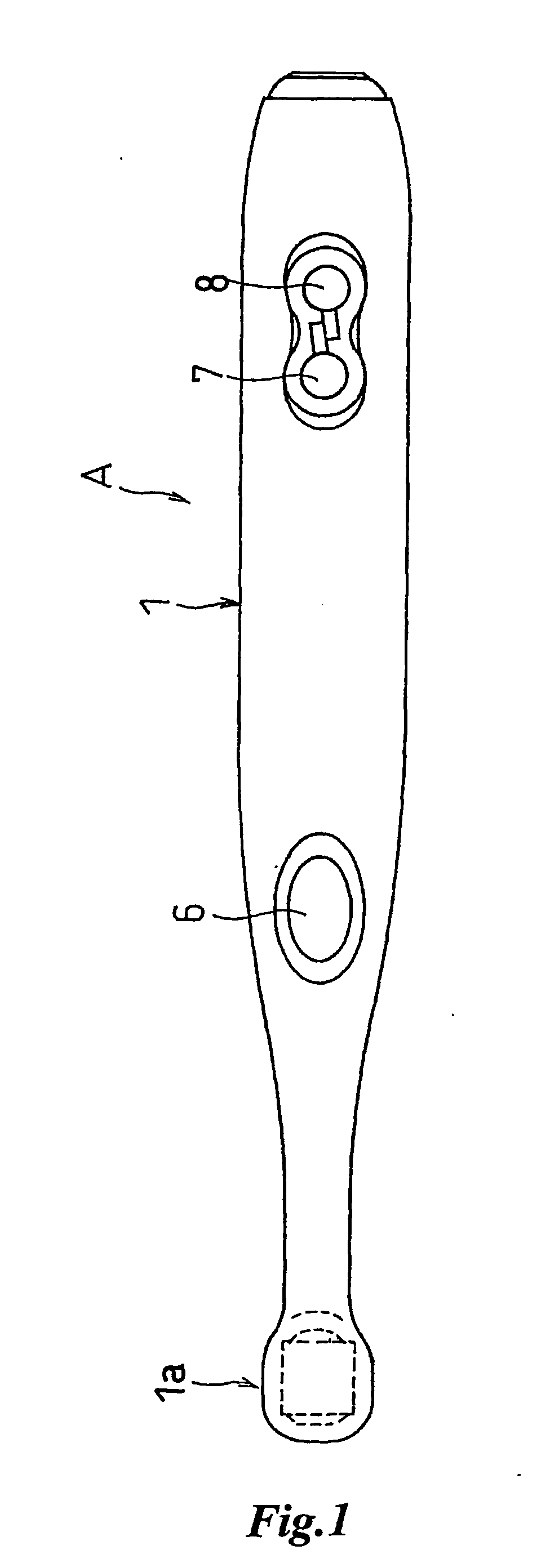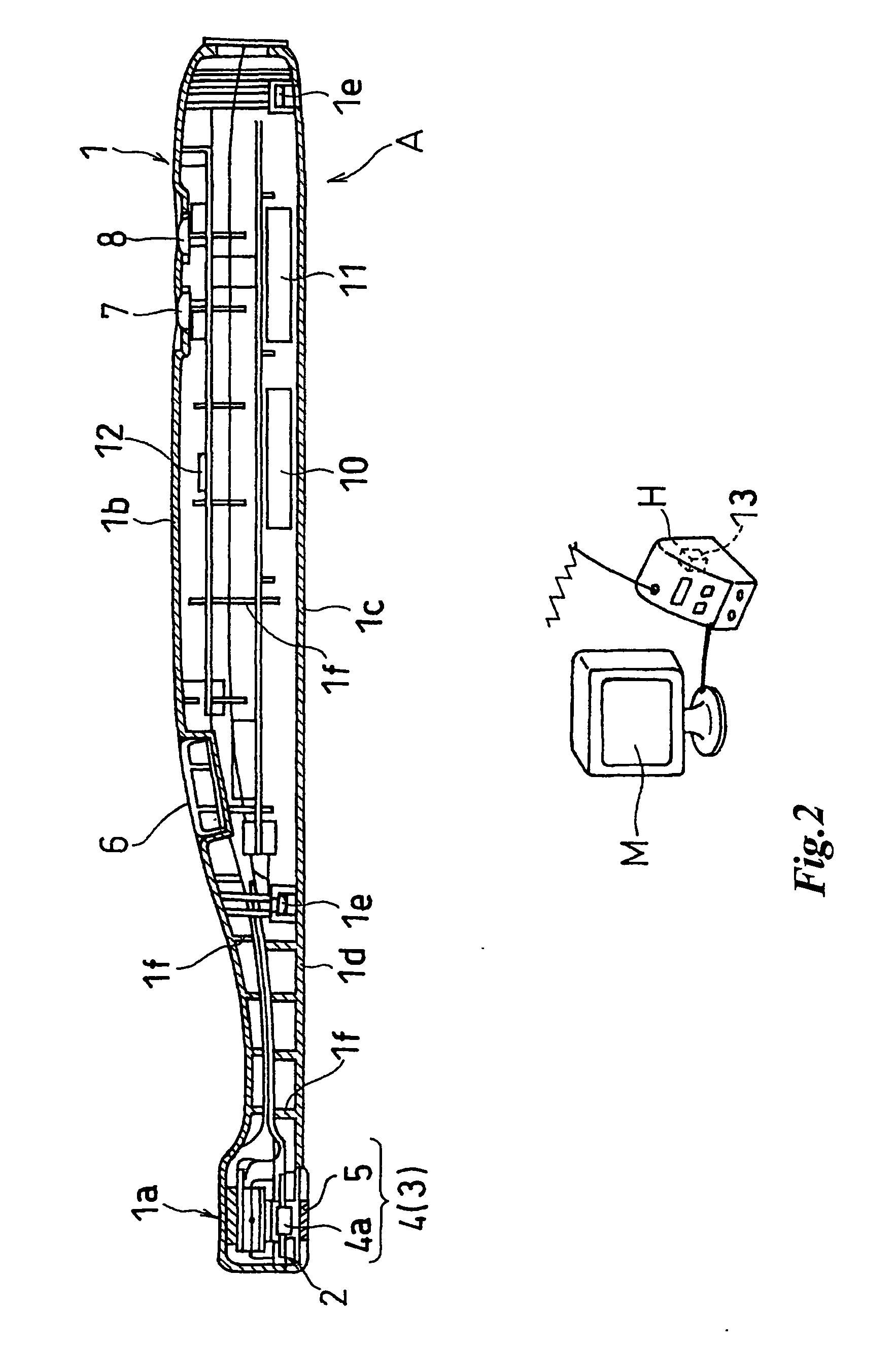Living Body Observing Apparatus, Intraoral Imaging Apparatus and Medical Treatment Appliance
a technology of intraoral imaging and living body, applied in the direction of radiation diagnostic clinical applications, optical radiation measurement, lighting support devices, etc., can solve the problems of insufficient recognition of the condition inside the surface layer, inability to further adequately recognize the condition, tooth caries, etc., to improve the accuracy of subsequent treatment, improve the diagnostic and clinical value, and natural color tone
- Summary
- Abstract
- Description
- Claims
- Application Information
AI Technical Summary
Benefits of technology
Problems solved by technology
Method used
Image
Examples
fourth embodiment
[0124]FIG. 12 shows an example of an intraoral imaging apparatus A3 having, as with the third embodiment, imaging means provided with optical path changing means and having the head part 1a separable into a head part 1a1 and a base part 1a2, with portions in common with the third embodiment provided with the same numerals. Specifically, on the inner surface of the cylindrical head part 1a1, the mirror (or prism) 18 as the optical path changing means is so mounted as to form an angle of substantially 45 degrees with respect to the optical axis described above, while, in the cylindrical base part 1a2 of the head part 1a, a solid state imaging device 4a constituting the imaging means 4 as the observation section 3 is installed. When the head part 1a1 and the base part 1a2 are linked together via link means 26 to be described later, an inner cylindrical part between this mirror 18 and the solid state imaging device 4a is provided as the light guide path 19 for the imaged light.
[0125] A...
fifth embodiment
[0129]FIGS. 13A to 13C are diagram showing examples of a living body observing apparatus of the present invention embodied in a medical irradiation head device, with 13A as a conceptual diagram with the device in use, 13B as an enlarged sectional view of irradiation means, and 13C as the same diagram of a modified example. The medical irradiation head device B in the figure is composed of head fitting means 29 fitted on the head of an operator D, and irradiation means 2 mounted on this head fitting means 29. The head fitting means 29 in the illustrated example is shown as a fastening belt or an elastic belt, although not limited thereto, and thus head fitting means of this type heretofore known in the medical field may be applicable.
[0130] The irradiation means 2 is oscillatablly fitted to a mounting base 34 provided at a position in the head fitting means 29 corresponding to the forehead portion of the operator D, and its irradiation angle with respect to an irradiation field is a...
sixth embodiment
[0137]FIGS. 14A and 14B show examples of a medical irradiation head device B1 having packaged irradiation means 2 composed of a plurality of types (three types in the illustrated example) of LEDs (or bare chips) 35c, 35d, and 35e as emission sections 35. FIG. 14A is a conceptual diagram showing the device in use, and FIG. 14B is a partially cut-away enlarged perspective view showing the irradiation means 2. Specifically, the irradiation means 2 is, as described above, composed of the exciting light emitting LED (exciting light emission section) 35c, and the white light LED 35d and the red light LED 35e as illumination light emission sections, which are disposed at the bottom of a cup-like casing 30a, and is oscillatably mounted on the mounting base 34. A light switch 34b is provided with three switch sections corresponding to these emission sections 35, and the operator D can selectively operate these switch sections to irradiate a desired light in accordance with a diagnostic purpo...
PUM
 Login to View More
Login to View More Abstract
Description
Claims
Application Information
 Login to View More
Login to View More - R&D
- Intellectual Property
- Life Sciences
- Materials
- Tech Scout
- Unparalleled Data Quality
- Higher Quality Content
- 60% Fewer Hallucinations
Browse by: Latest US Patents, China's latest patents, Technical Efficacy Thesaurus, Application Domain, Technology Topic, Popular Technical Reports.
© 2025 PatSnap. All rights reserved.Legal|Privacy policy|Modern Slavery Act Transparency Statement|Sitemap|About US| Contact US: help@patsnap.com



